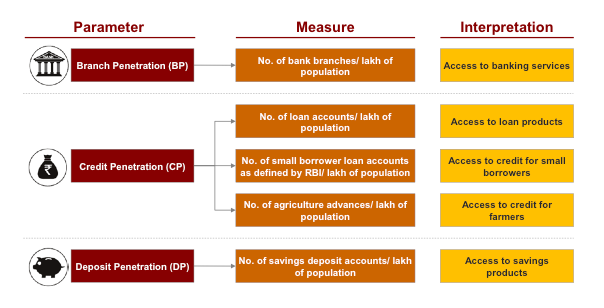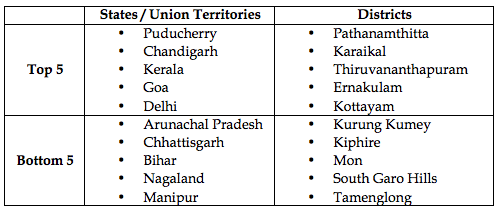Financial inclusion is a key enabler of economic and social development. The effectiveness of the financial inclusion agenda in India can be significantly enhanced if there are objective ways to measure it. CRISIL, therefore, decided to create a tool that would help policy-makers, regulators, and financial sector intermediaries at large in measuring the extent of financial inclusion, both at a broader, and disaggregated level. This vision was the genesis of CRISIL Inclusix – India’s first comprehensive measure of financial inclusion in the form of an index. In creating this index, CRISIL has leveraged its knowledge of the financial services sector and expertise in creating world-class analytical frameworks and indices.
CRISIL Inclusix is a comprehensive measure of financial inclusion
CRISIL Inclusix is a one-of-its-kind tool to measure the extent of financial inclusion in India. CRISIL Inclusix has a comprehensive coverage, covering all 35 states and union territories, right down to each of the 632 districts as on March 2011. It is a relative index on a scale of 0 to 100, and combines three critical parameters of basic banking services — branch penetration, deposit penetration, and credit penetration —into one metric.
The unique feature about CRISIL Inclusix is its use of non-monetary aggregates whilst calculating financial inclusion. Till now, most of the measures of financial inclusion have focused on an analysis of either the aggregate amount of deposits or loans in a particular region. Whereas, CRISIL Inclusix uses parameters that focus only on the ‘number of people’ whose lives have been touched by various financial services, rather than on the ‘amounts’ deposited or loaned. This helps negate the disproportionate impact of a few high-value figures on the overall picture.
CRISIL has developed this index with support from the Reserve Bank of India (RBI) and the Ministry of Finance. The index is an outcome of nearly two years’ effort in developing the methodology and rigourous analysis spanning over 2,00,000 data points across 165 banks. Data for computing the index was provided by RBI. The latest data available is as at March 2011.
The index is scalable and can include additional parameters
Currently the index has been calculated based on the data related to the banking system (scheduled commercial banks and regional rural banks). The index is scalable and can accordingly accommodate additional parameters or other forms of financial services. Over time, as consistent and comprehensive data becomes available, the index can be made more multidimensional. For instance, when the data related to NBFCs or MFIs becomes available, this can be incorporated in calculating financial inclusion. The index also has the flexibility to include other forms of financial services such as insurance and pension. We are already in discussions with other regulators and industry associations for sourcing relevant, consistent and comprehensive data.
CRISIL Inclusix uses robust methodology
CRISIL Inclusix follows a robust, transparent, and yet easy to understand approach. Its methodology is similar to other global indices, such as UNDP’s Human Development Index. CRISIL Inclusix is a relative index that incorporates various forms of basic financial services, listed in the chart below, into one single metric.
CRISIL Inclusix uses five parameters to measure the three key dimensions of financial inclusion (namely, Branch Penetration, Deposit penetration and Credit Penetration).

The calculation of CRISIL Inclusix follows a two-step process, starting with the normalisation of parameters. After the normalization process, the parameter indices become independent of units and dimensions; thus they can be aggregated with relative ease. In this process, CRISIL Inclusix employs a modified version of the ‘Min-Max’ method, which facilitates inter-temporal comparison of the index. The maximum is defined as the ideal value for each parameter.
The second step entails the aggregation of the three dimensions, each representing the three parameters (BP, CP, and DP) used in the analysis. In the step, the Euclidean Distance Method is used to calculate the distance between any two points in an ‘n-dimensional’ space. This method of aggression satisfies all intuitive properties of an index such as Normalisation, Anonymity, Monotony, Proximity, Uniformity, and Signaling (or NAMPUS in short).
Key highlights
The key findings of the analysis are:
- Low, albeit improving overall score: The all-India CRISIL Inclusix score of 40.1 is relatively low. It is a reflection of under-penetration of formal banking facilities in most parts of the country. It is a reflection of under-penetration of formal banking facilities in most parts of the country. Just one in two Indians has a savings account, and only one in seven Indians has access to banking credit. In fact, the bottom 50 scoring districts have just 2 per cent of the country’s bank branches. However, there are clear signs of improvement in the CRISIL Inclusix score over the past three years – to 40.1 in 2011, from 37.6 in 2010 and 35.4 in 2009. It is also encouraging to note that 618 out of 632 districts reported an improvement in their scores during 2009-2011.
- Wide disparity in financial inclusion: Wide disparities exist across India and within states in terms of access to financial services. India’s six largest cities have 11 per cent of the country’s bank branches. At the other end of the scale, there are four districts in the North-Eastern region with only one bank branch each.
- Deposit penetration is the key driver of financial inclusion: The number of savings bank accounts, at 624 million, is close to four times the number of loan accounts at 160 million.
- More focus on Credit Penetration (CP) is needed: Overall financial inclusion is constrained by lack of CP. CP score is the least amongst all three parameters across all regions, except South.
- Encouraging improvement in branch efficiency: In the bottom 50 districts, there is an encouraging improvement in branch efficiency. In these districts, the number of savings deposit accounts per branch has improved by 20 per cent to 6,073 as on March 2011 from 4,919 as on March 2009.
- Southern Region shows highest financial inclusion: The Southern region leads the financial inclusion drive in the country, with a CRISIL Inclusix score of 62.2 in 2011. Six out of the top 10 states with the highest CRISIL Inclusix score are from the Southern region. Southern region leads across all three dimensions of financial inclusion. This region has highest credit penetration — the number of loan accounts per lakh of population at 17,142 in the Southern region is nearly twice of the all-India average.
- Top states/ Union Territories and districts

Benefits and uses of CRISIL Inclusix
CRISIL Inclusix provides a bird’s eye view of the state of financial inclusion in India. At the same time, it gives ground-level information on the progress made on the inclusion front even in the remote districts of rural India. This two-pronged approach holds immense potential for policy-makers, regulators, and bankers as it helps to identify priorities, design focused programmes to push the inclusion agenda and most importantly, measure the progress made.
CRISIL will update this analysis on a regular basis to monitor progress. CRISIL will also endeavor to make the index more comprehensive in future by adding additional parameters and/or providers of financial services as and when comprehensive and reliable data becomes available.



4 Responses
Sir, congratulations on the launch of CRISIL Inclusix.
While the number of savings and credit accounts per lakh of population is a direct and very important parameter to track, we look forward to introduction of parameters that reflect the ‘quality’ of financial inclusion efforts. This would entail measures such as the frequency of transactions in savings bank accounts (whether through physical branches or through BC locations). The frequency of transactions determines how well the savings account is being used as a short term liquid savings instrument. Opening of a savings bank account and maintenance of a minimum balance without any
transactions would indicate poor depth. Credit Penetration is currently measured as the number of loan accounts per lakh of population. Perhaps, CRISIL could track the credit-to GDP ratio at the district or state level, as a measure of financial depth.
Tracking the role of banks and RRBs in financial inclusion is a good beginning, but we hope that CRISIL Inclusix will take a more comprehensive view of financial inclusion, to include the role of other institutions such as NBFCs, institutional BCs, Section 25 Companies and others in credit delivery and deposit mobilization.
Looking forward to more coverage and insights from CRISIL Inclusix.
Inclusix is clearly not the India’s first comprehensive measure of financial inclusion in the form of an index.
See this work conducted by the French Institute of Puduchery:
http://www.rume-rural-microfinance.org/spip.php?rubrique28
http://www.rume-rural-microfinance.org/IMG/pdf_Poster_Cyril_Fouillet_Bergamo_Boulder.pdf
It is perhaps the first of its kind to track FI on an on-going basis. Of course, as in other tools, this too could be fine tuned over time. Since Coop Banks are excluded from the index, it is not sure whether the five measures (no. of branches/ lakh of population; number of loan accounts / lakh of population etc.,) used would reflect only the performances of those of CBs and RRBs. Similarly, the quantum of loans or deposits and as mentioned by Deepti, the frequency of transactions can also be included in the index.
Dear Pawan Agrawal
The five parameters for measuring three key dimensions of Financial inclusion of CRISIL Inclusix are relevant topically from institutional perpectives.. However from the perspective of overall expected outcome of financial inclusion, one more key dimension with some parameters for measuring the status of financial inclusion after inclusion also as the better half of FI mission ( unfortunately ignored) is therefore required . Along with this, there could be four dimensions: while first three would help for measuring the outcome of financial inclusion in terms of the status of financial inclusion (branch, credit &deposit penetration) for interpreting quantitatively the extent of accessibility and No. of a/cs opened ) and suggested fourth one could capture most importantly no. of accounts of nascent inclusion sustained after inclusion or no. of a/c subsequently
remaining inoperative and defunct /closed having the status of exclusion. This would facilitate qualitative interpretation on acceptability or adaptability or appropriateness of the products &
services deployed by the respective financial institution for the said purposes.
The above argument is placed in the context of persistent phenomenon of drop outs/push outs/mortality/defunct /inoperative accounts/closed observed in all the states in MFI/SHG system in India . Evidently the reports on Micro finance India State of the sector 2008 by N.Srinivasan (pages 23 to 25) and the latest 2012 by V.Puhazhendi
( 22 to 23) have highlighted this qualitative dimension pertaining to the status of those included through MFI/SHG –bank linkage system. In the case of savings led inclusion, despite introduction of No Frill A/C many accounts have become defunct or
inoperative subsequently as revealed form MIcro save research study on Dormancy
in No Frill account (NFA), 2010. On the pther hand, the report of the committee on Financial inclusion Jan 2008 ( Dr C.Rangarajan as Chairman- GOI) has asserted “ The SHG-Bank linkage programme is a major plank of the strategy for delivering financial services to the poor in a sustainable manner” (Page 77) and “ MFIs could play a significant role in facilitating inclusion, as they are uniquely positioned in reaching out to the rural poor” (Page 87) .This continued drop out phenomenon in BANK
–SHG linkage model therefore causes concern on the validity of intended outcome financial inclusion
All these above facts suggest the imperative need to perceive through the lens of CRISIL Inclusix the fourth dimension (better half of the FI mission ) also for reflecting the status of financial inclusion with qualitative parameter, measure and interpretation
after financial inclusion at household level of so called included . This is also a value addition to CRISIL rating system as it takes cognizance of economic dimension of institutions and social dimension of the poor clients as well in the process of meaningful financial inclusion.
Thank you for sharing my views
Dr Rengarajan